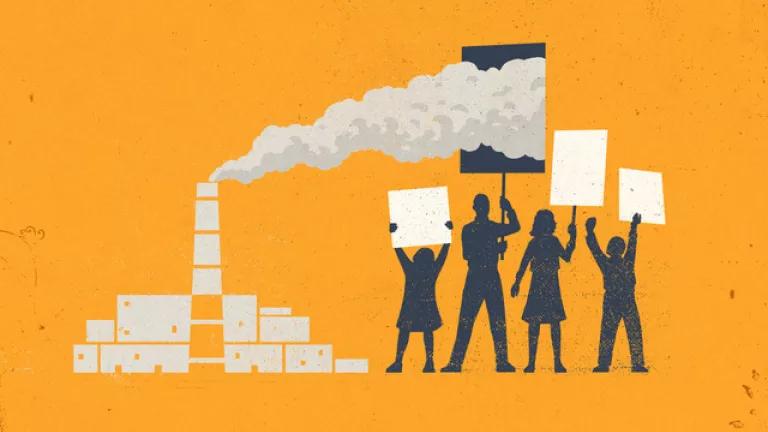How to Block Big Polluters
A step-by-step guide to protecting your community from dirty development projects.

No one likes ugly, pollution-spewing businesses—especially in our own neighborhoods. But we don’t have to sit helplessly as they contaminate the air we breathe and the water we drink. Stopping them, or at least getting more oversight and review of their potentially destructive plans, requires just two things: awareness and action.
Awareness
Potential polluters seeking a location for an unpopular project often rely on lack of awareness. If they need approval from a local zoning board, for example, and no one from the community attends the public meeting to challenge their project, they win. Don’t let that happen.
- Do your homework. Environmental issues are often legally and scientifically complex. In reading or learning about a proposed undesirable facility in your community, you might want to bring in outside expertise. Network with other citizen groups that have dealt with similar situations. Ask professors, scientists, or other experts to help explain confusing issues.
- Attend local government meetings. Development decisions for a community are typically made by local zoning or planning boards and city councils. Find out when these groups meet and what’s on the agenda. Show up if anything pertaining to your neighborhood is being discussed.
- Watch out for notices about potentially polluting projects. Pay particular attention to plans for: incinerators, landfills, waste transfer stations, water pollution control or sewage treatment plants, diesel bus or truck depots and parking lots, rail stations, oil or gas facilities, highways, airports, metal-plating businesses, and auto body or auto repair shops. Also be wary of any proposed change in zoning or in the municipality’s or county’s master plan or community environmental plan, or any proposed new development or creation of a redevelopment zone.
Action
The other way polluters win is if citizens lack the motivation, organization, or clout to mount an effective opposition to a project.
- Rally your neighbors. Clearly outline the project and the potential impact in an email or social media blast, or just print fliers and go door-to-door. Set up a meeting so you can start building your movement and shaping your plan.
- Dig for some dirt. If an outside private company is behind the proposal, find out if it has previous fines for environmental violations on the books. Start with a good, old-fashioned Google search for news stories, and then check out Right-to-Know Net; its databases can tell you who’s releasing toxic chemicals, who’s being sued, who’s not complying with environmental regulations, and much more. ECHO, a tool from the U.S. Environmental Protection Agency, also outlines which existing facilities are violating environmental regulations.
- Build your case. What are the secondary impacts of the project? For example, if a landfill, incinerator, or transfer station is proposed, you probably also need to think about the health and environmental hazards of the additional diesel truck traffic. And how bad is your local air and water quality right now? Enter your zip code into Environmental Defense's Scorecard to get an idea of the current sources of air and toxic chemical pollution in your community.
- Determine your goal. As a group, decide on the preferred outcome—whether it’s to block a project, push for stricter pollution controls or a health assessment, or change zoning rules to stop additional harmful development. Focus on getting to that solution rather than just stating the problem. Some nonprofit groups or law firms help grassroots organizations by providing advice, education, or legal assistance to help you set your path to success.
- Pressure decision makers. A local body, such as a zoning board or city council, might hold the power to clear the way for new projects in your community. Write to board members expressing your concerns or, even better, ask for a private meeting with your group so you can help influence their decision. Check with your state or local environmental department to find out which governing body is in charge of issuing the permits that allow certain types of facilities to discharge waste into the air and water. Contact them and make your concerns known. Also try enlisting the help of an elected official or administrator—a city council member, a county commissioner, or an engineer at the local department of environmental protection.
- Keep your coalition and your voice strong. You know what they say about the squeaky wheel. Expand your movement by recruiting influential local business and religious leaders, environmental groups, health experts, property owners, and parent and school groups. Hold regular meetings and events, and let local reporters know when and where they are.
This NRDC.org story is available for online republication by news media outlets or nonprofits under these conditions: The writer(s) must be credited with a byline; you must note prominently that the story was originally published by NRDC.org and link to the original; the story cannot be edited (beyond simple things such as grammar); you can’t resell the story in any form or grant republishing rights to other outlets; you can’t republish our material wholesale or automatically—you need to select stories individually; you can’t republish the photos or graphics on our site without specific permission; you should drop us a note to let us know when you’ve used one of our stories.
Clean Air Warrior
Coal Is Literally Killing Us
Five Ways the GOP-Led Congress Plans to Attack the Environment